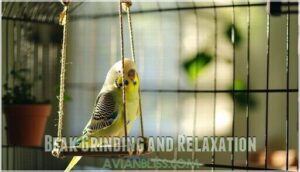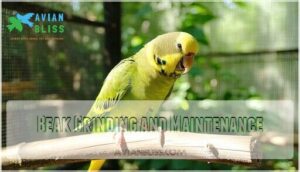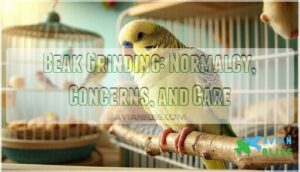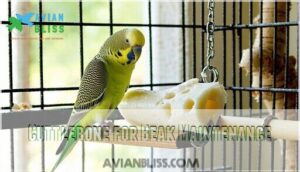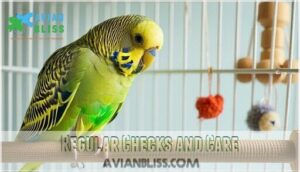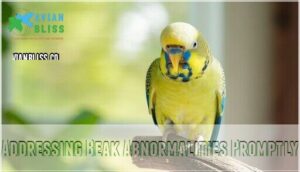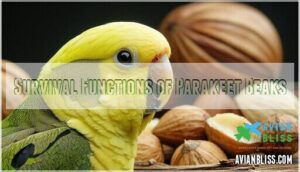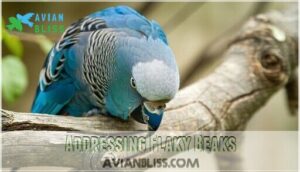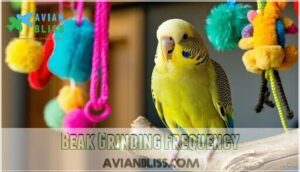This site is supported by our readers. We may earn a commission, at no cost to you, if you purchase through links.
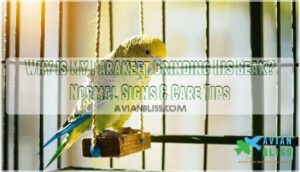
This rhythmic clicking sound happens when your feathered friend feels safe and comfortable, much like a cat’s purr.
You’ll often hear this gentle grinding before naptime or when he’s settling in for the evening.
The behavior serves two purposes: it’s a natural way for parakeets to self-soothe and it helps maintain their beak’s proper shape by naturally trimming it, think of it as your bird’s version of filing his nails.
While beak grinding is perfectly normal, there’s more to understand about when it signals pure contentment versus potential concerns.
Table Of Contents
- Key Takeaways
- Reasons for Beak Grinding
- Beak Grinding and Relaxation
- Beak Grinding and Maintenance
- Beak Grinding: Normalcy, Concerns, and Care
- Signs of Beak Issues
- Beak Maintenance
- Survival Functions of Parakeet Beaks
- Addressing Flaky Beaks
- Beak Grinding and Comfort
- Beak Grinding Frequency
- Frequently Asked Questions (FAQs)
- Why is my parakeet making a grinding noise?
- Why do parrots grind their beaks?
- Do parakeets grind their beaks?
- What does it mean if a bird has a grinding beak?
- What is beak grinding?
- Why do Raptors grind their beaks?
- Why are my parakeets grinding their beaks?
- Do birds’ beaks grind when sick?
- What does an unhealthy parakeet beak look like?
- Can beak grinding indicate pain or discomfort in parakeets?
- Conclusion
Key Takeaways
- Your parakeet’s beak grinding signals pure contentment – When you hear those soft scratching sounds, it means your bird feels completely safe and relaxed in their environment, much like a cat’s purr.
- It’s a natural pre-sleep ritual that helps them unwind – You’ll notice this behavior most often when your parakeet is settling down for a nap or preparing for bedtime, showing they’re ready to rest peacefully.
- Beak grinding serves as built-in maintenance for beak health – This instinctive behavior naturally trims and shapes your parakeet’s beak, preventing overgrowth and keeping it in perfect working condition for eating and preening.
- You should only worry if you notice sudden changes in grinding patterns – While normal grinding is healthy, watch for excessive grinding, complete cessation, or accompanying symptoms like lethargy or appetite loss, which warrant a vet visit.
Reasons for Beak Grinding
You’re hearing those soft grinding sounds because your parakeet is telling you everything’s just right in their world.
Those gentle grinding sounds signal your parakeet feels completely safe and content in their world.
This natural behavior signals contentment and helps keep their beak healthy by preventing overgrowth, much like how we might stretch before settling in for a good nap, which is a sign of overall well-being.
Natural Behavior for Contentment
When parakeets grind their beaks, it’s pure contentment in action.
This natural behavior signals your Happy Parakeet is relaxed and satisfied with their Safe Environment. The rhythmic grinding acts as a Relaxation Signal, much like a cat’s purr, indicating your bird feels secure and happy.
- Contentment Indicator: Parakeet beak grinding shows your bird trusts their surroundings completely
- Pre-Sleep Ritual: This bird behavior typically occurs when they’re preparing to rest peacefully
- Natural behavior: Regular grinding promotes healthy beak maintenance while expressing inner satisfaction
Sign of Satisfaction With Life
Looking at your parakeet’s beak grinding habits, you’re witnessing a happy parakeet expressing deep contentment with their world.
This natural behavior signals emotional wellbeing and trust building between you and your feathered friend.
When your bird feels secure in their environment, they’ll often grind their beak as positive reinforcement that life’s pretty good, it’s like their way of saying "all’s well" and showing trust.
Linked to Preparation for Napping
Beyond showing contentment with their life, you’ll notice your parakeet’s beak grinding becomes part of their pre-sleep ritual. This bedtime behavior signals they’re winding down for rest.
- Sleepy Sounds: The gentle grinding creates a calming indicator that naptime approaches
- Pre-Sleep Ritual: It’s their natural relaxation signal before settling in
- Bedtime Behavior: This parakeet sleeping habit shows they feel secure enough to rest
- Calmness Indicator: The grinding tells you they’re ready for peaceful slumber
Providing safe chewable toys can also contribute to beak health.
Instinctive Prevention of Beak Overgrowth
Nature’s wisdom drives your parakeet’s beak grinding instincts.
This natural behavior prevents overgrowth, maintaining proper beak shape and health.
Regular grinding keeps beaks sharp and functional, supporting essential activities like eating and preening.
It’s built-in maintenance that guarantees your bird’s well-being through natural trimming and wear.
| Beak Grinding Benefits | Natural Process | Health Impact |
|---|---|---|
| Prevents overgrowth | Daily wear and tear | Maintains eating ability |
| Shapes beak properly | Self-trimming action | Supports preening |
| Removes debris | Polishing motion | Prevents infections |
| Keeps edges sharp | Grinding surfaces | Aids food handling |
| Maintains length | Controlled wearing | Guarantees comfort |
Beak Grinding and Relaxation
You’ll notice your parakeet grinding his beak most often when he’s settling down for a nap or preparing for bedtime.
This rhythmic, raspy sound is like a bird’s version of a contented sigh – it’s his way of telling you he feels safe and relaxed in his environment.
Commonly Associated With Relaxation
Imagine this: when your parakeet settles into beak grinding, you’re witnessing nature’s version of a bedtime ritual.
This natural behavior serves as a relaxation signal and comfort indicator, showing your bird feels safe and content.
The gentle sounds represent environmental contentment and stress-free grinding, confirming your parakeet’s well-being through parakeet sounds that signal pure contentment.
Raspy Sounds Before Napping
Those raspy sounds you hear before your parakeet settles down for a nap are perfectly normal signs of relaxation.
The gentle grinding noise comes from your bird’s contentment as they prepare for sleep.
Each parakeet produces slightly different sounds – some barely audible, others more pronounced.
This natural behavior shows your feathered friend feels safe and secure in their environment, making it a positive indicator of their well-being.
Part of Their Routine Before Resting
Your parakeet’s beak grinding forms part of their natural pre-sleep routine, acting as a comfort signal that promotes calmness.
This relaxation cue helps them unwind before rest, serving as a contentment indicator that everything’s okay in their world.
Here’s what makes this normal behavior so important:
- Pre-sleep ritual – Like brushing teeth before bed, grinding helps parakeets shift into sleep mode
- Stress relief – The rhythmic motion releases tension from their day of chirping and playing
- Beak maintenance – While relaxing, they’re also keeping their beak in tip-top shape
Think of it as your bird’s version of counting sheep.
When you hear those soft, raspy sounds, your parakeet is basically saying "goodnight" in their own special way.
This natural behavior signals they feel safe and content in their environment.
Signals a Content and Relaxed Parakeet
When you hear those soft grinding sounds, you’re witnessing your happy parakeet’s ultimate trust indicator.
This natural behavior shows they feel completely safe in their environment.
Your bird’s pre-sleep ritual of beak grinding demonstrates environmental comfort and contentment – it’s their way of self-soothing before sleep.
Think of it as their version of a satisfied sigh after a good day, a clear sign of contentment.
Beak Grinding and Maintenance
Your parakeet’s beak grinding isn’t just a quirky habit—it’s actually a clever form of natural maintenance that keeps their beak in perfect working condition.
Think of it like a built-in nail file that prevents overgrowth and maintains the proper shape needed for eating, preening, and exploring their world, which is a very natural process.
Trimming Beaks Naturally
Your parakeet’s beak grinding works like natural sandpaper, keeping their beak perfectly trimmed and healthy.
This instinctive behavior prevents costly vet visits and maintains healthy beak condition through consistent natural abrasion.
- Cuttlebone benefits provide calcium while offering a grinding surface for beak wear
- Chew toys supplement natural beak maintenance and satisfy grinding instincts
- Environmental enrichment through varied textures supports healthy beak grinding behavior
- Diet impact affects beak hardness, making proper nutrition essential for effective grinding
Preventing Overgrowth
Your bird’s beak-grinding habit serves as nature’s built-in maintenance system, preventing problematic overgrowth that could interfere with eating and preening.
This self-trimming behavior keeps beaks properly shaped and functional through consistent beak wear.
| Overgrowth Prevention | Natural Method | Benefits |
|---|---|---|
| Beak trimming through grinding | Daily grinding sessions | Maintains proper beak length |
| Cuttlefish bone interaction | Scraping and nibbling | Provides calcium and beak wear |
| Chew toys engagement | Regular chewing activity | Promotes healthy beak maintenance |
| Environmental enrichment | Varied perch textures | Encourages natural beak trimming |
| Dietary needs fulfillment | Balanced nutrition | Supports overall beak health |
Without this natural beak maintenance, your parakeet would face serious challenges.
Regular vet checkups help monitor beak condition and catch potential overgrowth issues early.
Research Supporting Beak Health
Scientific studies back up what parakeet owners observe daily – beak grinding serves essential health functions.
Veterinary studies confirm that this natural behavior maintains proper beak keratin structure, preventing overgrowth that could impact eating.
Research shows grinding benefits include debris removal and nerve stimulation.
Avian veterinarians recognize these health indicators as signs of proper dietary impact from calcium-rich foods like cuttlefish bone.
Regular Trimming for Proper Shape
Regular trimming isn’t something you’ll actively do—your parakeet handles this naturally through grinding behavior.
Here’s how proper beak shape maintenance works:
- Natural grinding action keeps beaks at ideal length and prevents overgrowth
- Professional filing may be needed if abnormal beak growth occurs
- Shape maintenance happens automatically through daily grinding sessions
- Overgrowth prevention relies on providing cuttlebone and rough perches for natural beak trimming
Never attempt beak trimming at home—consult an avian vet for any beak abnormalities.
A balanced diet is vital for maintaining beak health.
Essential for Overall Well-being
Think of parakeet beak grinding as your bird’s daily wellness routine—it’s that important! This natural behavior serves multiple functions that keep your feathered friend thriving both physically and mentally.
Here’s why beak grinding matters so much for your parakeet’s overall wellbeing:
- Mental Stimulation: The grinding action engages their senses and provides calming brain activity
- Social Interaction: Content birds often grind their beaks when feeling secure with their flock (that’s you!)
- Stress Relief: This relaxation technique helps your parakeet unwind after busy days
When your parakeet displays this contentment behavior, they’re basically telling you their world feels safe and balanced. The rhythmic motion promotes better sleep patterns while maintaining proper beak function—truly a win-win for your pet’s health and happiness.
Beak Grinding: Normalcy, Concerns, and Care
You’re probably wondering if that grinding sound from your parakeet’s beak is normal – and the good news is that it usually is.
This behavior is typically a sign of a content, healthy bird, though there are a few things you should watch for to make certain everything’s okay.
Generally Normal and Healthy Behavior
You’re witnessing a perfectly normal behavior when your parakeet grinds his beak.
This natural behavior serves as a contentment indicator and relaxation signal, showing your bird feels safe and happy.
Parakeet beak grinding is actually a healthy sign that demonstrates your pet’s well-being.
Rather than worrying, consider it a compliment to your care – your feathered friend is content enough to engage in this natural beak maintenance behavior, which is a clear sign of your pet’s overall well-being.
Veterinary Support for Normalcy
Veterinarians recognize parakeet beak grinding as completely normal behavior that shows contentment and relaxation.
Your avian veterinarian will reassure you that this grinding indicates a happy, healthy bird. During vet checkups, they’ll monitor your parakeet’s overall health and note any grinding changes as part of their behavioral assessment.
Here’s what veterinary professionals want you to know:
- Your parakeet’s grinding means they feel safe and secure – it’s their way of saying "all is well"
- Regular vet visits help catch any behavioral signs that might indicate health issues early
- A balanced diet supports healthy beak grinding and overall well-being
- Providing chew toys gives your bird natural outlets for beak maintenance
- Professional guidance helps you distinguish normal from concerning grinding patterns
Your vet will educate you on recognizing healthy parakeet beak grinding versus unusual sounds that warrant attention, giving you confidence in caring for your feathered friend.
Consulting a Vet for Unusual Patterns
When monitoring your parakeet’s beak grinding behavior, any unusual patterns warrant professional evaluation.
While normal grinding sounds indicate contentment, sudden changes in frequency, intensity, or accompanying behaviors may signal underlying health issues.
An avian veterinarian can assess whether grinding changes stem from stress, illness, or physical discomfort.
Watch for these key warning signs:
- Grinding Changes – Excessive grinding or complete cessation of normal patterns
- Distress Signs – Lethargy, appetite loss, or abnormal droppings alongside grinding
- Beak Deformities – Overgrowth, chips, or unusual shape affecting grinding ability
- Vocal Changes – New sounds or distress calls during grinding episodes
Early intervention improves outcomes when health issues affect natural behaviors.
Recognizing Normal Sounds
Normal beak grinding produces gentle, rhythmic sounds that vary between individual birds.
You’ll hear soft scratching, clicking, or grinding noises—like sandpaper rubbing together.
These natural sounds range from barely audible to moderately loud, depending on your parakeet’s personality.
Sound variations and grinding volume are perfectly normal, indicating your bird feels safe and content in their environment.
No Established Standard for Frequency
Pet owners often worry about their bird’s parakeet beak grinding frequency, but there’s no magic number to follow.
Individual variation means some birds grind daily while others do it weekly.
Age influence, environmental impact, and personal habits all affect grinding consistency, making overall health a key consideration.
This normal behavior varies greatly between birds, so focus on your parakeet’s health rather than counting grinding sessions, and recognize that individual variation is a significant factor.
Observing Beak Condition Regularly
Every responsible bird owner knows that consistent beak checks are your best defense against health problems.
You’ll want to examine your parakeet’s beak weekly, looking for changes that might signal trouble ahead.
Here’s what to watch for during your regular beak health inspections:
- Beak symmetry – Any crooked or uneven growth patterns
- Color changes – Unusual darkening, lightening, or discoloration
- Texture irregularities – Rough, flaky, or overly smooth surfaces
- Growth rate – Rapid overgrowth or stunted development
- Injury signs – Cracks, chips, or bleeding areas
Regular checks help you catch beak condition issues early, ensuring your parakeet maintains peak health and can eat comfortably.
Physical Handling Not Recommended
While regularly checking your parakeet’s beak condition is important, avoid physically handling their beak during grinding sessions.
This hands-off approach prevents injury risk and reduces handling stress for your bird.
Instead, observe from a distance to assess their normal behavior and build trust through alternative interaction methods like gentle talking or offering treats.
| Why Avoid Handling | Potential Risks | Better Alternatives |
|---|---|---|
| Delicate beak structure | Bleeding or cracks | Visual observation only |
| Stress during grinding | Infection from damage | Gentle verbal interaction |
| Natural contentment behavior | Loss of trust | Offering favorite treats |
| Hygiene concerns | Vet bills for injuries | Patience and distance |
Signs of Beak Issues
While beak grinding is typically harmless, you’ll want to watch for signs that something’s wrong with your parakeet’s beak.
A chipped or bleeding beak needs immediate veterinary attention, though minor damage often heals naturally as the beak grows.
Chipped or Bleeding Beak Requires Attention
While most beak grinding is normal, chipped or bleeding parakeet beaks need immediate veterinary care. These injuries can lead to serious complications if ignored.
Watch for these urgent signs:
- Visible blood – Active bleeding requires emergency attention
- Difficulty eating – Your bird may starve without proper beak function
- Behavioral changes – Unusual quietness often signals pain
Bleeding causes include accidents, fights, or underlying health issues. For parakeets needing help, consider products for beak repair. Infection risk increases with open wounds. An avian veterinarian can assess repair options and provide proper veterinary care. Prevention tips include removing sharp objects and monitoring for signs of injury regularly.
Beak Damage Can Be Lightly Repaired
Like a skilled mechanic with the right tools, you can help your parakeet’s beak heal from minor damage.
Small chips and superficial cracks often undergo natural repair as the beak grows and sheds outer layers.
Apply vitamin E oil to support healing, provide cuttlebone for calcium, and temporarily soften their diet.
However, bleeding beaks need immediate attention from an avian veterinarian to prevent complications.
Supplying essential beak maintenance helps promote healthy growth.
Beaks are strong and sharp, essential for grabbing, manipulating, and feeling objects in the wild.
Signs of Beak Issues
Permanent Damage May Require Filing
When severe beak damage occurs, professional filing becomes necessary to restore proper function.
An avian veterinarian can safely reshape your parakeet’s beak using specialized filing techniques, minimizing filing risks while promoting healthy beak regrowth.
Don’t attempt home filing—beak abnormalities and overgrowth require professional expertise.
You can find the right avian vet supplies online.
Alternative solutions may include dietary adjustments, but severe beak damage typically needs veterinary intervention to prevent eating difficulties and guarantee your bird’s well-being.
Importance of Beaks in The Wild
In the wild, your parakeet’s ancestors relied on their beaks as multi-purpose survival tools.
These remarkable bird beak structures weren’t just for eating – they were nature’s Swiss Army knives.
Wild parakeets depend on their beaks for:
- Foraging and Food Processing – Cracking seeds, stripping bark, and accessing nectar from flowers
- Environmental Navigation – Climbing branches, testing surfaces, and manipulating nesting materials
- Defense and Communication – Protecting territory, establishing dominance, and social bonding through preening
Understanding these beak functions helps explain why proper beak anatomy matters so much for your pet’s wellbeing and survival activities.
A balanced diet helps prevent beak overgrowth issues.
Cuttlebone for Beak Maintenance
Your parakeet’s beak works like a built-in nail file when they use cuttlebone for beak maintenance.
This calcium-rich supplement naturally wears down their beak while providing mineral supplementation.
Place cuttlefish bone securely in their cage and monitor consumption – proper placement guarantees safe access.
Cuttlebone alternatives like mineral blocks work too, supporting overall parakeet beak health through regular use.
Beak Maintenance
Your parakeet’s beak needs regular maintenance to stay healthy and functional.
You can help by providing cuttlebone for calcium and using vitamin E oil on flaky beaks to restore their natural shine and hydration.
Applying Vitamin E Oil
When your parakeet’s beak looks flaky or dull, vitamin E oil can work wonders.
Apply a small amount using a cotton swab once or twice weekly to restore hydration and create a healthy, shiny appearance.
This oil application helps address nutrient deficiency signs while supporting overall beak care. Monitor your parakeet’s response and discontinue if irritation occurs.
Cuttlebone for Calcium and Beak Health
Throughout your parakeet’s life, cuttlefish bone serves as nature’s calcium powerhouse for peak beak health.
This natural supplement offers essential nutrients while providing a perfect grinding surface for beak maintenance.
Here are three key cuttlebone benefits:
- Calcium Absorption – Delivers key minerals for strong beak structure
- Natural Grinding Surface – Allows self-trimming through regular use
- Proper Placement – Mount securely in cage for easy access
Different cuttlebone types offer various textures, though standard varieties work perfectly for most parakeets.
While alternative supplements exist, cuttlefish bone remains the gold standard for parakeet beak care.
Beak’s Role in Survival Activities
Your parakeet’s beak serves as nature’s ultimate multi-tool, essential for wild survival and daily captivity needs.
Beak strength enables food manipulation while preening importance keeps feathers pristine.
This remarkable defense mechanism supports countless survival activities through natural behavior.
- Cracking seeds with impressive beak strength
- Delicately manipulating food pieces like a skilled chef
- Preening feathers with surgical precision for ideal health
- Climbing cage bars using beak as an anchor point
- Gripping perches securely during sleep and rest
- Communicating emotions through gentle beak movements
- Exploring new toys and objects with curious investigation
- Defending territory when feeling threatened or protective
- Grooming hard-to-reach spots that claws can’t access
Regular Checks and Care
Just like keeping your car running smoothly requires regular tune-ups, your parakeet’s beak needs consistent attention.
Schedule monthly beak checks with your avian veterinarian to spot beak abnormality signs early.
At home, monitor for hydration and shine—dull beaks may need calcium supplementation.
Professional beak filing handles serious issues, but preventative beak care through regular beak checks keeps your feathered friend healthy and happy.
Addressing Beak Abnormalities Promptly
When you spot parakeet beak abnormalities like overgrowth or misalignment, quick action prevents bigger problems.
Watch for discomfort signs—difficulty eating or unusual grinding patterns signal trouble.
An avian veterinarian can assess serious issues, while preventative measures like cuttlebone and proper nutrition support healthy beak maintenance.
Don’t wait—early veterinary intervention keeps your feathered friend comfortable and healthy.
Survival Functions of Parakeet Beaks
Your parakeet’s beak isn’t just for cracking seeds—it’s a remarkable multi-tool that serves countless survival functions in the wild and captivity.
From grabbing and manipulating objects to sensing textures and temperatures, your bird’s beak requires proper care to support all these essential activities.
Multifunctional Beaks
Beyond simply eating and drinking, your parakeet’s beak serves as nature’s ultimate multi-tool.
This remarkable feature acts as their primary means of interacting with the world around them.
Your bird’s beak functions as:
- Beak as tool for cracking tough seeds and nuts
- Preening assistance to maintain clean, healthy feathers
- Object manipulation for climbing and positioning items
- Sensory input device to explore textures and temperatures
- Wild survival equipment for building nests and defending territory.
Understanding these multifunctional beaks helps you appreciate why proper beak maintenance and beak health matter so much for your feathered friend’s overall well-being.
Importance in Grabbing, Manipulating, and Feeling Objects
Your parakeet’s beak serves as a sophisticated tool for grasping food, object manipulation, and providing sensory feedback.
Through preening assistance, it keeps feathers clean and healthy.
During nest building, the beak manipulates materials with precision.
This normal behavior supports essential parakeet beak functions, making proper beak maintenance vital for beak health and overall well-being.
Supporting Appropriate Care
Understanding your parakeet’s needs helps you provide the best care possible.
When you recognize that beak grinding signals contentment, you’ll better support their well-being through proper parakeet care strategies.
- Enrichment strategies keep your bird mentally stimulated and reduce stress-related behaviors
- Diet optimization guarantees proper nutrition for healthy beak development and overall parakeet health
- Safe environment creation allows natural bird behavior like comfortable beak grinding to flourish
- Regular checkups with an avian vet help monitor beak condition and catch issues early
Beak Care for Thriving in Captivity
Keeping your feathered friend’s beak healthy in captivity requires attention to their natural behaviors.
Your parakeet’s beak serves as their Swiss Army knife—eating, climbing, and exploring their world.
| Care Element | Action Needed |
|---|---|
| Diet and beak nutrition | Provide calcium-rich cuttlebone |
| Environmental enrichment | Offer safe chewing toys |
| Monitoring beak growth | Check weekly for overgrowth |
| Professional beak trimming | Consult avian vet if needed |
| Daily beak maintenance | Observe grinding behaviors |
Regular parakeet care includes watching for changes in beak health and maintaining proper captivity beak health through environmental enrichment and balanced nutrition.
Addressing Flaky Beaks
Sometimes you’ll notice your parakeet’s beak looking a bit rough or flaky, which can be concerning but is often easily addressed.
A flaky beak typically signals that your bird needs some extra moisture and nutrients to restore that healthy, shiny appearance.
Treating With Vitamin E Oil
When your parakeet’s beak looks dry and flaky, vitamin E oil works like a moisturizer for cracked skin.
This natural remedy helps restore your bird’s beak health without harsh chemicals.
Here’s how to use vitamin E oil effectively:
- Choose pure vitamin E oil – avoid products with additives that could harm your parakeet
- Apply sparingly once daily – a tiny drop goes a long way on the beak surface
- Watch for absorption – healthy beaks should absorb the oil within minutes
The oil penetrates the keratin layers, addressing flaky beak causes from the inside out. Regular application helps prevent beak abnormalities while supporting natural healing.
Restoring Hydrated and Shiny Appearance
A few drops of vitamin E oil can transform your parakeet’s flaky beak into a healthy, gleaming surface.
This simple oil application method works wonders for restoring proper hydration and natural shine.
- Gently apply vitamin E oil to dry, flaky areas
- Massage oil into beak surface for better absorption
- Use cotton swab for precise application on small areas
- Repeat treatment weekly until beak health improves
- Monitor progress as shine restoration indicates successful hydration methods
Indications of Nutrient Deficiency
While proper nutrition keeps your parakeet’s beak healthy, certain deficiencies can cause visible problems.
A dietary imbalance often shows up as flaky, brittle beaks that lack their natural shine.
Calcium deficiency and vitamin deficiency are common culprits behind beak deterioration.
You’ll notice feather quality declining alongside beak issues, plus lethargy signs that signal poor bird nutrition.
| Nutrient Deficiency | Beak Symptoms |
|---|---|
| Calcium | Soft, misshapen texture |
| Vitamin A | Flaky, brittle appearance |
| Vitamin D3 | Weak keratin structure |
| Protein | Cracks and chips |
| Minerals | Abnormal color, dullness |
Calcium supplements and balanced avian health practices prevent these issues.
Your parakeet’s beak condition reflects overall bird health – pale, cracked, or overly soft beaks mean it’s time to evaluate their diet and consult your vet.
Monitoring and Addressing Changes Promptly
Watch your parakeet’s beak changes like a hawk—any shifts in grinding frequency, duration, or texture signal it’s time for action.
Behavioral shift signs and discomfort indicators shouldn’t be ignored, as early vet intervention beats waiting when you spot these red flags.
Proactive health monitoring means consulting your veterinarian promptly when parakeet signs seem off, protecting your bird’s overall health.
Maintaining Optimal Beak Condition
Several factors contribute to ideal parakeet beak health beyond addressing flaky surfaces.
Regular beak maintenance prevents beak overgrowth, which can interfere with eating and grooming.
Provide cuttlebone importance for natural grinding and calcium supplementation.
Apply Vitamin E oil to restore moisture and shine.
Monitor for beak abnormalities requiring professional trimming by an avian veterinarian to maintain proper function.
Beak Grinding and Comfort
When you hear that soft scratching or grinding sound from your parakeet, it’s actually a sign they’re feeling completely content and relaxed.
This natural behavior is painless and pleasurable for your bird, much like how we might stretch or yawn when we’re comfortable.
Beak Grinding as a Sign of Contentment
When your parakeet grinds his beak, it’s one of the clearest bird contentment signals you’ll witness.
This natural behavior indicates happy parakeets who feel completely secure in their environment. Much like a cat’s purr, beak grinding serves as your bird’s pre-sleep ritual, showing environmental satisfaction and relaxation.
The gentle rasping sound means your parakeet trusts you enough to let his guard down. This contentment display also supports beak health maintenance, making it a win-win behavior that reflects your excellent care.
Understanding The Noise
Most parakeet noise from beak grinding resembles sandpaper rubbing together, creating rhythmic scratching sounds.
These audible signals vary in sound texture and volume variation between birds—some grind silently while others produce clicking or grinding noises.
The grinding sound indicates your parakeet feels safe and content in their environment.
No Pain or Discomfort in Normal Grinding
Rest assured, your feathered friend isn’t experiencing any discomfort during normal beak grinding.
This pain-free behavior actually brings them pleasure through nerve stimulation. When you hear those gentle grinding sounds, it’s your parakeet’s contentment signal – like a cat’s purr but scratchier.
This self-soothing activity keeps healthy beaks in top condition while signaling pure relaxation.
- Pain-free behavior – Normal grinding stimulates nerve endings pleasurably
- Contentment signal – Grinding indicates your parakeet feels safe and happy
- Self-soothing ritual – Helps them unwind before naps or bedtime
- Healthy maintenance – Keeps beaks properly trimmed and polished naturally
Beak Grinding Frequency
Now that you understand your parakeet’s beak grinding signals comfort, you’re probably wondering about frequency patterns.
Most parakeets don’t grind their beaks on a strict schedule—it’s more like a "when the mood strikes" behavior that varies by individual personality and circumstances.
Here’s what affects your parakeet’s beak grinding frequency:
- Daily frequency: Ranges from several times daily to once every few days
- Age correlation: Older birds typically grind more than younger ones
- Seasonal variation: May increase during molting or temperature changes
- Stress influence: Grinding duration decreases when birds feel anxious or threatened
Your parakeet’s habits will develop their own rhythm.
Some birds are regular "grinders" while others are occasional participants in this parakeet beak grinding behavior.
Offering them safe chewable toys can also help maintain beak health.
Frequently Asked Questions (FAQs)
Why is my parakeet making a grinding noise?
Like a tiny sandpaper symphony, your parakeet’s grinding sound signals pure contentment. This natural behavior helps maintain their beak health while showing they’re relaxed and happy in their environment.
Why do parrots grind their beaks?
Beak grinding signals contentment and relaxation in parrots. They’re telling you they feel safe and happy! It’s natural maintenance behavior that keeps their beaks healthy and properly shaped.
Do parakeets grind their beaks?
Picture tiny sandpaper kisses as your parakeet’s beak meets beak—yes, parakeets absolutely grind their beaks.
This rhythmic scratching sound signals pure contentment, helping them maintain beak health while preparing for rest, which is crucial for their overall well-being and also involves beak health.
What does it mean if a bird has a grinding beak?
When your bird grinds its beak, it’s showing pure contentment and relaxation.
This natural behavior helps maintain beak health by wearing it down and signals they’re feeling safe and happy in their environment.
What is beak grinding?
Your parakeet’s beak grinding sounds like sandpaper rubbing together.
It’s when they rub their upper and lower beaks, creating a soft scratching noise.
This natural behavior helps maintain beak health and signals contentment.
Why do Raptors grind their beaks?
Unlike parakeets, raptors don’t typically engage in beak grinding for relaxation.
These birds grind their beaks to sharpen it as part of the preparation process for hunting and handling large prey items like bones or feathers.
Why are my parakeets grinding their beaks?
Contentment flows through your parakeets’ beaks like gentle waves against shore. They’re grinding to maintain beak health, signal relaxation, and prepare for rest—perfectly normal, happy behavior.
Do birds’ beaks grind when sick?
Yes, sick birds can grind their beaks, but it’s different from healthy grinding.
When you’re dealing with illness, excessive or unusual grinding often signals discomfort, stress, or pain rather than contentment, especially alongside other symptoms.
What does an unhealthy parakeet beak look like?
A picture’s worth a thousand words, and an unhealthy parakeet beak shows clear warning signs.
You’ll notice discoloration, overgrowth, cracks, flaking, or unusual shapes that prevent proper eating and grooming functions.
Can beak grinding indicate pain or discomfort in parakeets?
Beak grinding usually signals contentment, but excessive or sudden changes can indicate pain from overgrown beaks, misalignment, or illness. Watch for accompanying symptoms like lethargy or appetite loss.
Conclusion
As they say, "contentment is the greatest wealth," and your parakeet’s beak grinding perfectly embodies this wisdom.
Understanding why your parakeet is grinding his beak helps you recognize when he’s truly happy versus when something might need attention.
This natural behavior signals relaxation, maintains beak health, and shows your feathered friend feels secure in his environment.
Keep providing proper care, monitor for any unusual changes, and enjoy knowing that gentle grinding sound means you’re doing something right as a bird parent.

